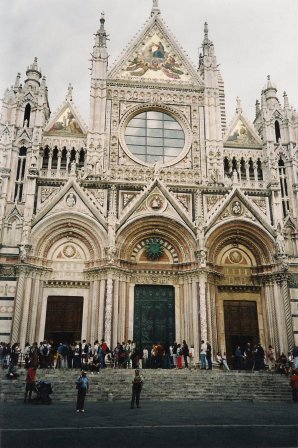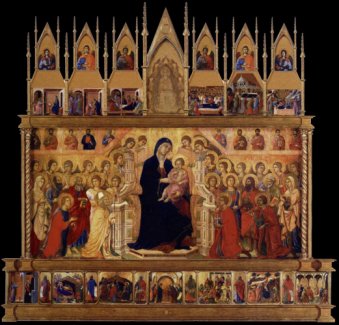|
Duccio: The Maesta |
|
|
The Maesta by Duccio is one of the greatest works of the early
fourteenth century. Commissioned in 1308, it was installed in the
cathedral at Siena on the ninth of June 1311 with much ceremony and
civic rejoicing. It remained at the high altar of the cathedral for nearly two hundred years. In 1505 it was moved to a side chapel owing to cathedral repairs. In 1771 it was taken down, taken apart, then partially reassembled, but with many parts missing. Some of these are now in galleries around the world; some have disappeared, it would seem, forever. The parts that remain in Siena are now in the Museum of the Opera del Duomo. In their new setting, it is impossible to recapture the sense of mystery and divine presence of the cathedral setting – they are on display in what amounts to a rather sanitised lecture room. However, given that the intention of the work is at least in part didactic, perhaps this is not entirely inappropriate. This study looks at the individual elements of each panel and where appropriate provides some background information. What it can’t do is give a sense of the sheer scale of the work. Unless otherwise stated, the panels are in the museum in Siena. |
|
|
Function The prime function of the altarpiece is as focus for devotion. The image of the Madonna was probably covered by a curtain for most of the time. This would be drawn aside at key liturgical moments, and the impact would undoubtedly have been stunning. The smaller panels provide the didactic function. The story of the life of the Virgin and the infancy of Christ appear on the front predella and crowning section, and the life of Christ in 42 panels on the reverse. Timothy Hyman in Sienese painting tells us that these rear panels, viewed only from the closed choir, were the object of devotion for the clergy and were hardly ever available to the general congregation. The third, implied function, was to glorify the city of Siena itself. Sacred and secular were not considered separate domains as they are today. The Virgin Mary is the dedicatee of the cathedral, and was the 'supreme protectress' of the city. The saints featured on the large front panel, all rather obscure, are the city's patrons. The inscription on the Virgin's throne asks her to intercede on the part of the city and grant it peace. |
|
|
|
Style The Maesta is sometimes described as ‘transitional’ between the Italo-Byzantine tradition, still very much alive in Siena, and the new style exemplified by Cimabue and Giotto showing more natural figures and a more realistic use of space. The Maesta is contemporary with Giotto’s frescoes in Padua, completed in 1305. I would prefer to say that Duccio, being aware of both traditions, made use of both old and new styles, as appropriate. This study As with so many great artworks, there is a lifetime's work here. Using a reconstruction of what the original may have looked like, I've tried to look at each image and explain its context, giving the biblical or other source where required. Click on the individual panels in the reconstructions for these details and a larger image. As time permits, I'll add more material. If you as as enraptured by it as I am, there's really only one option - go to Siena, arguably the most beautiful and unspoilt city in the world, and see it for yourself. |
|
Further
reading and links
Home
- explore the site |
|



